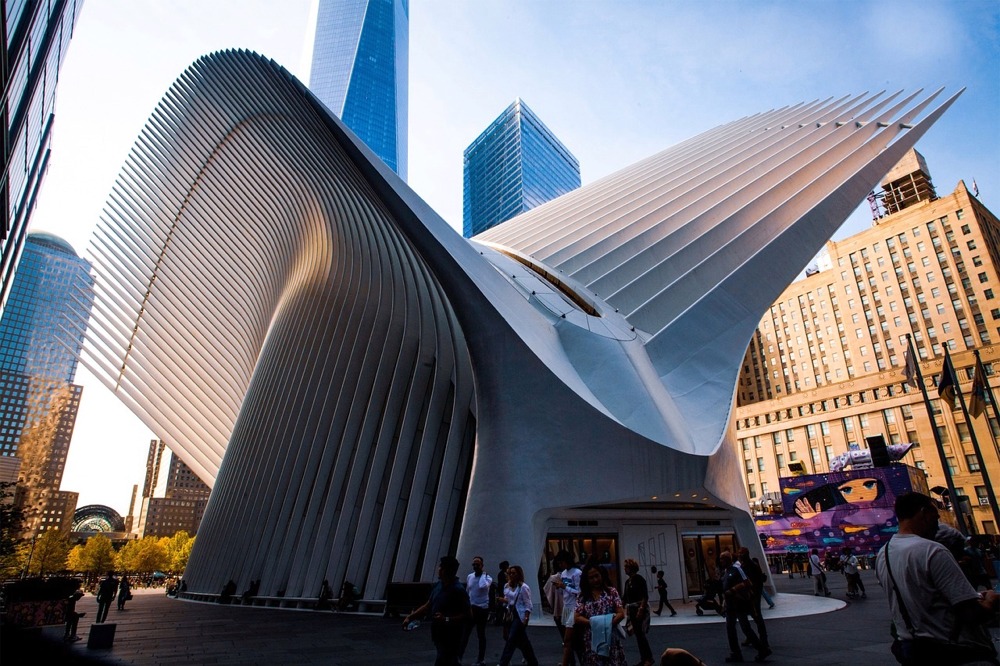Oculus Wings
One World Trade Center
Home > New York State Photographs > New York > The Oculus Wings at the One World Trade Center

The Oculus Wings, a magnificent architectural masterpiece situated at the center of the One World Trade Center transportation hub, seemed to beckon with an invitation to explore the beauty of the city. The photographer observed the wings from a distance, his admiration intensifying as he drew closer. He couldn't help but be struck by their immense beauty and the potential they held for flight.
The wings held a special kind of power over him. They seemed to symbolize hope, renewal, and resilience — a phoenix rising from the flames. Light and shadows danced across the sculpture, constantly changing the mood of the wings to something nuanced and mysterious.
The One World Trade Center rose behind the wings, bathing the buildings in a beautiful golden light. But the wings themselves were mostly in shadow, contrasting with the bright sky and creating a striking duality. At the north end of Battery Park City, the Winter Garden Atrium peeked out from beneath one of the wings, adding to the beauty of the scene.
The photographer felt a sense of awe as if he was standing at the edge of a great abyss. It was a reminder that the world was larger and more mysterious than he had ever realized. He realized that the Oculus Wings were not only a symbol of hope but also a reminder to remain open to the possibilities of the world.
Oculus World Trade Center Transportation Hub
The Oculus is a remarkable architectural marvel located at the World Trade Center transportation hub in Lower Manhattan, New York City. Designed by renowned Spanish architect Santiago Calatrava, the Oculus is a striking and futuristic structure that serves as both a transportation hub and a commercial space. It is a part of the extensive redevelopment efforts at the World Trade Center site following the September 11, 2001 terrorist attacks.
Design and Features
The design of the Oculus is characterized by its grand, sweeping curves that evoke the image of a bird in flight or a large, white dove. The structure features a distinctive rib-like pattern and a soaring, cathedral-like central hall. Key features of the Oculus include:
Grand Hall
The central space of the Oculus is an expansive, light-filled hall with soaring ceilings and abundant natural light. The open design creates a sense of awe and spaciousness.
Glass Roof
The Oculus is crowned by a massive, retractable glass roof that allows sunlight to flood the interior. The roof can be opened during favorable weather conditions, creating an indoor-outdoor experience.
Transportation Hub
The Oculus serves as a key transportation hub, connecting various modes of transportation. It provides access to the New York City Subway, the PATH train system, and several nearby transit options.
Retail Spaces
The Oculus houses a range of retail shops, restaurants, and boutiques within its interior. These commercial spaces create a shopping and dining destination for both visitors and commuters.
Symbolism
The design of the Oculus is meant to symbolize hope, renewal, and resilience in the face of tragedy. It stands as a symbol of the city's recovery and rebirth after the devastation of the September 11 attacks.
Function and Importance
The Oculus serves as an important transportation nexus in Lower Manhattan, providing a seamless connection between various transit options. It enhances the commuting experience for residents and visitors alike. Additionally, the Oculus plays a role in the revitalization of the World Trade Center site, contributing to the area's economic and cultural vitality.
One World Trade Center
The Oculus is located near the One World Trade Center, also known as the Freedom Tower, which is the main building at the World Trade Center site. The tower is a significant symbol of resilience and remembrance, honoring the victims of the September 11 attacks.
Overall, the Oculus stands as a testament to innovative architecture, urban renewal, and the ability of human ingenuity to transform tragedy into a symbol of hope and progress. Visitors to the Oculus are often struck by its awe-inspiring design and the powerful emotions it evokes.


